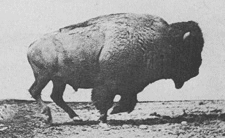

galloping buffalo's from...........Muybridge_Buffalo_sequence.jpg
The Metis buffalo hunters of Red River.
"Conspicuous in importance amongst the annual events in the colony are the journeys made to the Plains by the Buffalo hunters at different periods of the year. The parties belonging to the summer hunt start about the beginning of June, and remain on the Plains until the beginning of August. They then return to the settlement for the purpose of trading their pemmican and dried meat. The autumn hunters start during the month of August, and remain on the prairie until the end of October, or early November, when they usually return bringing the fresh or "green meat," preserved at that late season by the extreme cold." Red river by Hargrave 1871 (page 168) |
| flintlock 1850-1870 used in the North-West |
Pemmican
"The pemmican, which forms the staple article of produce from the summer hunt, is a species of food peculiar to Rupert's Land. It is composed of buffalo meat, dried and pounded fine, and mixed with an amount of tallow or buffalo fat equal to itself in bulk. The tallow having been boiled, is poured hot from the caldron into an oblong bag, manufactured from the buffalo hide, into which the pounded meat has previously been placed. The contents are then stirred together until they have been thoroughly well mixed. When full, the bag is sewed up and laid in store. Each bag when full weighs one hundred pounds. It is calculated that, on an average, the carcass of each buffalo will yield enough pemmican to fill one bag." Red river by Hargrave 1871 (page 168)
...read more..The Buffalo Hunt in 1858 Saskatchewan by Henry Youle Hind
...read more...1889_Hornaday,_Extermination_of_the_American_Bison
...read more..American_bison
...read about the Red_River_Trails
...read more "The remarkable history of the Hudson's Bay Company" (pages 363-375)
 |
| Metis drivers with Red River ox carts circa 1860 |
 |
| Red River Carts Leaving Fort Garry 1863 by A. Scott |
Red River Carts
"The operations connected with these Buffalo hunts give employment to somewhat over one thousand men and twelve hundred Red River carts. The people go to them with their families, who are employed in preparing the meat after the animals have been killed." Red river by Hargrave 1871 (page 169)
 |
| Peter Rindisbacher buffalo hunt in winter 1822-24 |
 |
| Paul Kane metis buffalo hunt June 1846 (edited) "The word given, the horsemen start in a body, loading and firing on horseback, and leaving the dead animals to be identified after the run is over. The kind of horse used is called a "buffalo runner," and is very valuable. A good one will cost from 50 to 70 pounds sterling. The sagacity of the animal is chiefly shewn in bringing his rider alongside the retreating buffalo, and in avoiding the numerous pitfalls abounding on the prairie. The most treacherous of the latter are the badger holes.
Considering the bold nature of the sport, remarkably few accidents occur. The hunters enter the herd with their mouths full of bullets. A handful of gunpowder is let fall from their "powder horns," a bullet is dropped from the mouth into the muzzle, a tap with the butt end of the firelock on the saddle causes the salivated bullet to adhere to the powder during the second necessary to depress the barrel, when the discharge is instantly effected without bringing the gun to the shoulder." Red river by Hargrave (pages 169-170)
Buffalo hunter spitting a bullet into a gun by Remington 1892 |
 |
| Paul Kane Buffalo Hunt In 1850 there were an estimated 20 million buffalo on the Great Plains of North America. In 1870 there may have been 14 million. A great slaughter of buffalo began in the 1870's and by 1885 only 20,000 remained. In 1895 there were less than a thousand. Today there are about 500,000 buffalo. ...buffalo population The lands where the buffalo once grazed in now home to over 110 million cattle, 96 million in the United States and 14 million in Canada. ....cattle population |

